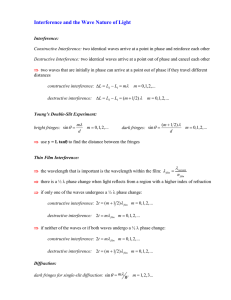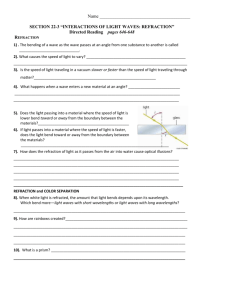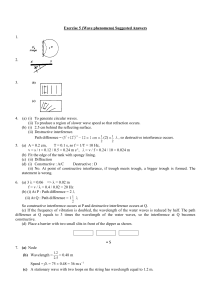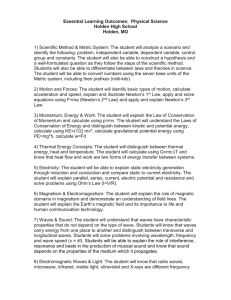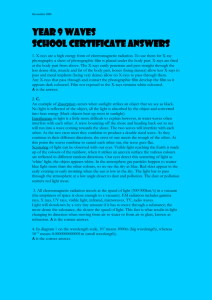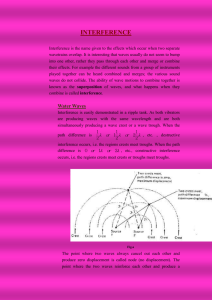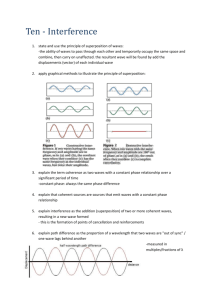Thin Films, Diffraction, and Double slit interference
advertisement
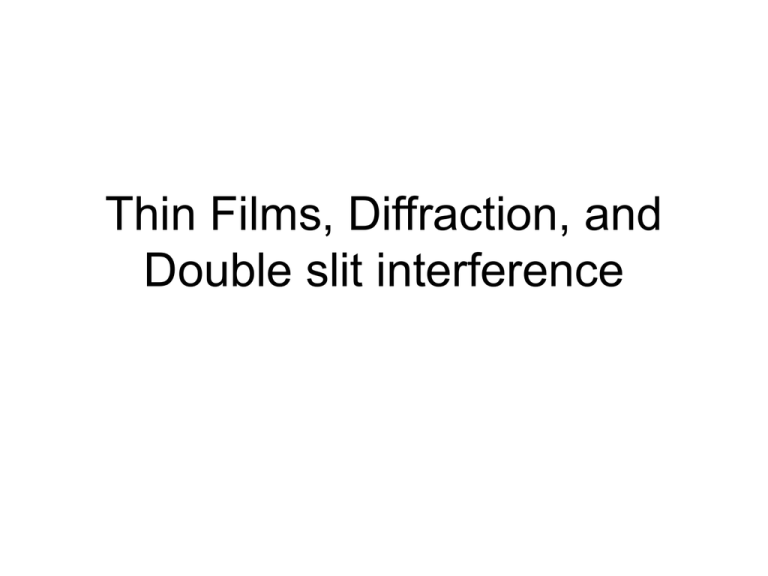
Thin Films, Diffraction, and Double slit interference Young's Experiment • Construction is reinforcement (adding) • Suppose you have two waves with the same phase at point P, and l1 and l2 are the length the waves have traveled • The waves differ by one wavelength • So l1 = 2¼ l and l2 = 3¼ l • So whenever l2-l1 = ml, where m = 1,2,3,…, there is constructive interference Cont. • Destruction is cancellation (subtraction) • Suppose you have two waves that are out of phase at point P, and l1 and l2 are the length the waves have traveled • The waves differ by one-half a wavelength • So l1 = 2¾ l and l2 = 3¼ l • So whenever l2-l1 = (m + ½)l, where m = 0,1,2,3…, there is destructive interference Coherent Sources • Two sources are coherent if the waves they emit maintain a constant phase relation. • This means the wave do not shift relative to one another • Lasers are coherent, incandescent bulbs are non coherent Young • In 1801, Thomas Young demonstrated the wave nature of light by overlapping light waves and showing interference • He was also able to determine the wavelength of light • When the path difference is = l, a bright fringe is made • When the path difference an odd multiple of ½ l, a dark fringe is made Cont • For Bright Fringes, sin • For Dark Fringes, sin m l d (m ) 1 2 l d Thin film interference • Young double slit experiment is one form of interference • Light is reflected off of both boundaries, but one ray travels further than the other • This causes the waves to “construct,” 0o, or 360o phase difference or “ destruct,” 180o phase difference. • The determining factor is the number of whole wavelengths Cont. • Using index of refraction n=c/v • Stating c = fl and vfilm = fl flvacuum lvacuum c n v fl film l film • When light travels to a more refractive material (e.g. air to gasoline), relection at the boundary occurs along with a phase change that is ½ of a wavelength in the film Cont. • When light travels to a less refractive material, there is no phase change • Example 3 pg 827 • Let “t” represent the thickness of the film • Since light goes from air to gasoline there is a 1/2l phase shift, so: • 2t + 1/2l = 1/2l,3/2l,5/2l,...subtracting ½ • 2t = 1l,2l,3l...so t = ml/2, m = 1,2,3 Cont. • Multicolored films • If the thickness is different at different parts of the film then different colors subtract, green subtraction would look magenta, red subtraction would look cyan Diffraction • The bending of light around obstacles • Christian Huygens (1629-1695) describes that Every point on a wave front acts as a source of tine wavelet that move forward with the same speed as the wave. • The wave front at a later instant is the surface that is tangent to the wavelets. • The amount of bending is determined by l/ W, where W is the width of the opening • For dark fringes sin = ml/W Diffraction Grating

